European Starling: Everything You Should Know
Updated: Dec. 07, 2022
European starlings are often scorned by bird-watchers for their aggressive behavior. But there's more to these colorful birds than you know.
Our editors and experts handpick every product we feature. We may earn a commission from your purchases.
European Starling Facts
Starlings are originally from Europe and Asia. One hundred European starlings were were released into New York City’s Central Park in 1890 and ’91 as part of an attempt to bring all of the birds mentioned in Shakespeare’s plays to America. Today, more than 200 million starlings populate the continent and they thrive in cities. The European starling gets its name not from the starry markings but from the way the short, tapered wings make the bird look like a four-pointed star in flight.
Check out the most common birds found in North America.
What Does a European Starling Look Like?
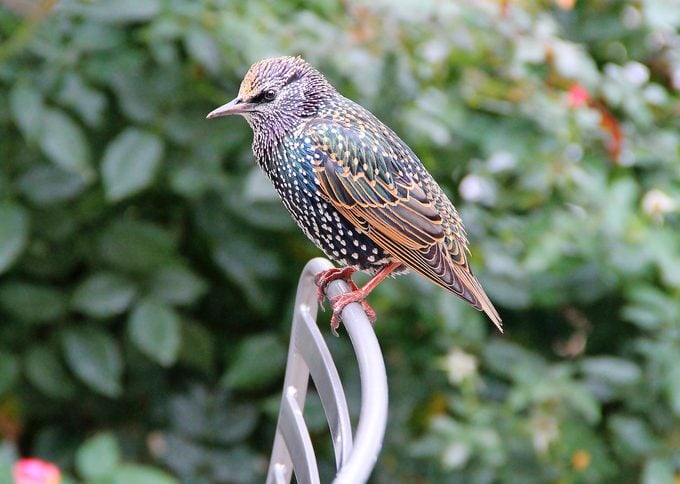
I saw this bird in Boston, and I was amazed by its coloring. What is it? asks Theresa St. John of Saratoga Springs, New York.
Kenn and Kimberly Kaufman: Many people don’t realize just how colorful the European starling can be, but you’ve captured a perfect portrait of an adult starling in very fresh plumage. Those reflections of purple and green are hard to see unless the light is exactly right. When the feathers are fresh, each one has a buff or white tip, creating a spangled look. And each feather on the wing is edged with rich golden brown. Starlings are not native to North America, and they sometimes cause problems for native birds. But since they’re here to stay, we have learned to appreciate their beautiful colors.
Learn how to get rid of blackbirds and grackles at feeders.
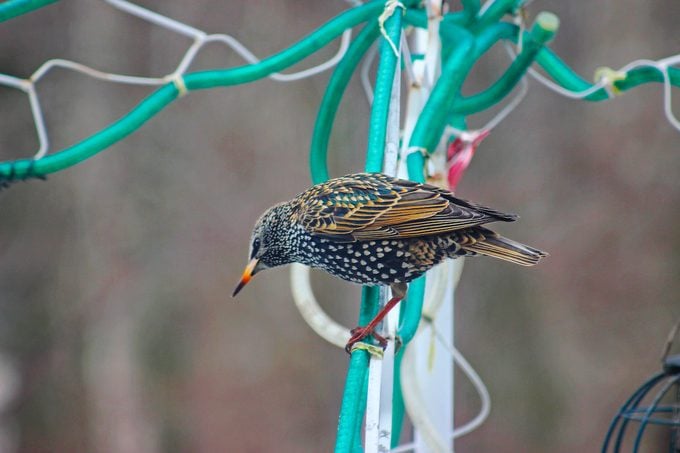
This bird was on my deck one winter morning and I can’t identify it. What is my mystery bird? asks Linda Harbour of Wareham, Massachusetts.
Kenn and Kimberly Kaufman: Although it’s not a rare bird, the European starling can be confusing when you see a lone individual in its full winter plumage. Most of us are more accustomed to seeing starlings in large flocks, or during spring or summer when they’re more solidly black. In fresh winter plumage, the starling has a beautiful pattern, with tan edges on the wings and big tan and white spots all over. The spots on this bird are important field marks. The starling’s shape, with spiky bill and short tail, helps to identify it in all seasons.
These pictures will change the way you look at black birds.
Juvenile European Starling
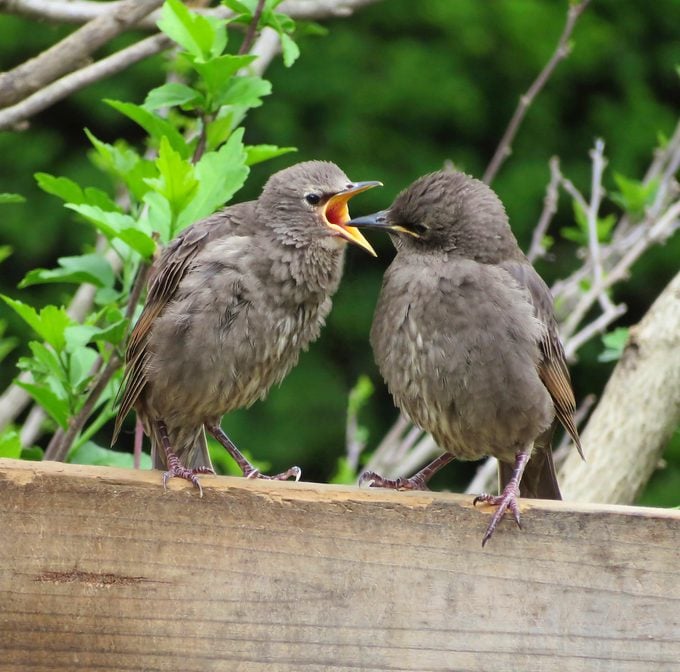
Katherine Marshaleck of Narberth, Pennsylvania, snapped this photo (above) of fledgling starlings. They are pale brown birds, unlike the colorful adults.
Psst—we found more pictures of super cute baby birds you need to see.
European Starling Nests
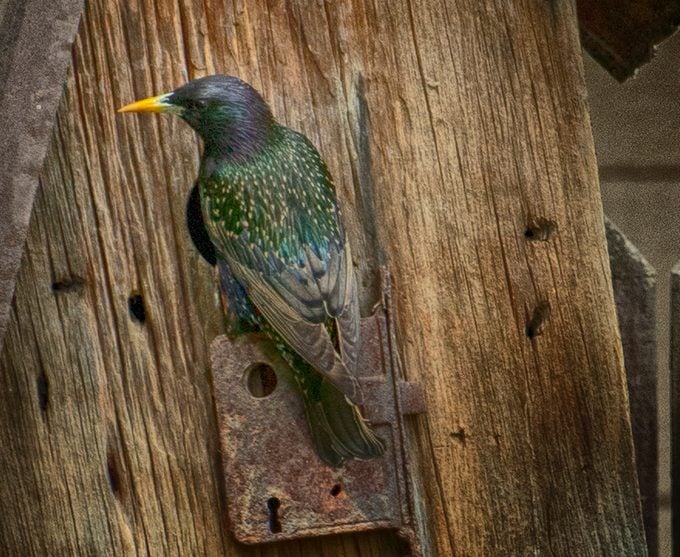
Starlings are smart, adaptable and tough. Unfortunately, they’ve thrived at the expense of some native birds, taking over cavity nesting sites and nest boxes from woodpeckers, bluebirds and other species. Most birds and their nests are protected by the Migratory Bird Treaty Act, which states that it is illegal to take, possess, import, export, transport, sell, purchase or barter any part of a nest or eggs unless you hold a valid permit. However non-native birds, like the European starling, aren’t protected by these laws.
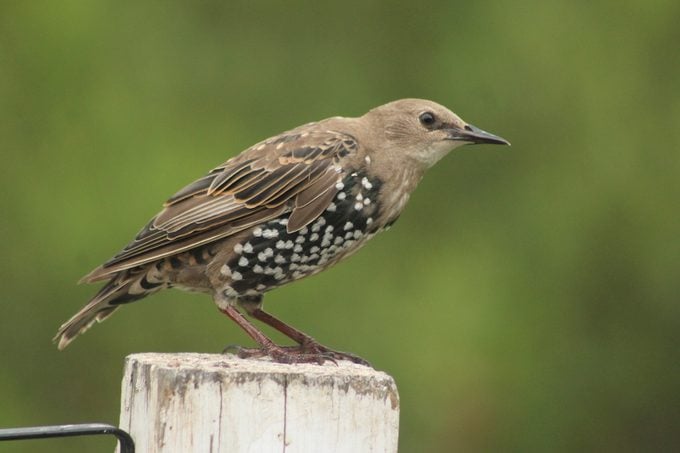
“Flickers started nesting in our Northern flicker house and the European starlings drove them away. The first year it happened, the starlings were successful hatching young, but an eastern chipmunk entered the house and killed the whole brood. In recent years, the starlings have really been driving the woodpeckers away. European starlings are an invasive species and are not protected by any laws. That allows you to discourage them in any way you see fit,” says birding expert George Harrison.
Here’s how to keep house sparrows out of bluebird boxes.
What Do Starlings Eat?
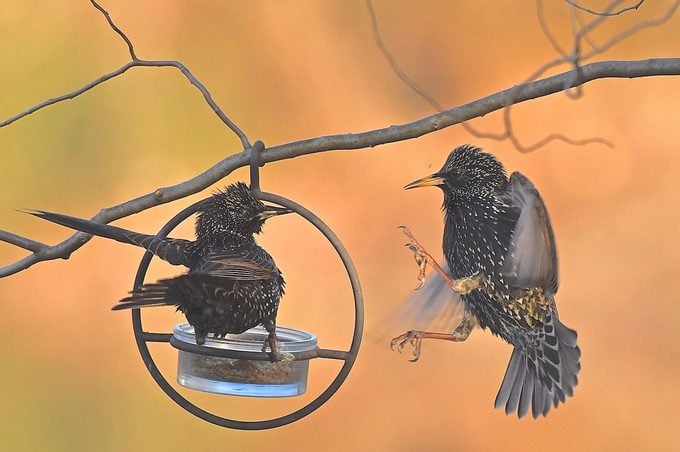
If you see a starling stabbing its bill into the ground, it’s looking for insects for its next meal. These birds also eat berries and seeds. Highly aggressive when it comes to bird feeders, starlings have a bad reputation. These boisterous birds love suet. It not unusual for them to consume an entire suet cake in one day. Look for starling-proof upside down suet feeders (food is accessible only from the bottom) or set up a suet feeder under a squirrel baffle to deter starlings. More acrobatic birds like nuthatches will still be able to use these feeders.
Starlings actively avoid safflower seeds. Field editor Ken Wellnitz of Davenport, Iowa, says, “I have had good luck using safflower in my yard. It attracts cardinals, finches, mourning doves and other songbirds. But starlings do not like it and they used to rule the feeder at times.”
A few winters ago, we had about two dozen starlings at our feeders at once. One particular bird was adept at protecting one side of the feeder, keeping the others away,” says Mary Baird of Trafalgar, Indiana.
Check out the best squirrel-proof bird feeders and 12 tips that work.
Starling Murmuration
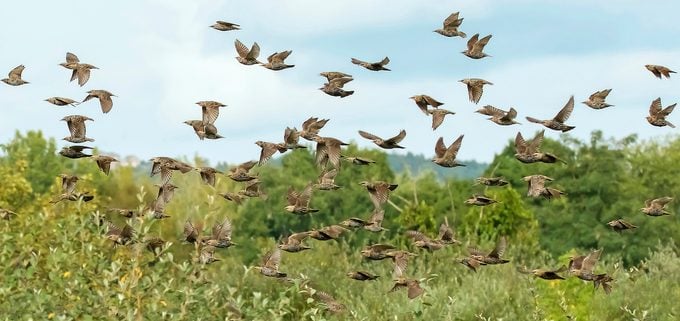
Starlings fly in large flocks and create amazing whirling balls in the sky. This phenomenon is called a murmuration. They may also flock with grackles and red-winged blackbirds.
“There were hundreds of these birds stripping nearby berry bushes one September morning. After I took this photo (above), I was surprised to learn that these birds are young starlings. I’d always thought that starlings only had black feathers. The darker bird on the right is either a female or young red-winged blackbird,” says Melissa Rowell of Vestal, New York.
Raven vs crow: Here’s how to tell the difference.
Do Starlings Migrate?
Many U.S. birders can see starlings year-round, but in non-breeding season some northern birds migrate short distances to warmer southern locations.
Discover the secrets of bird migration.
European Starling Songs and Sounds
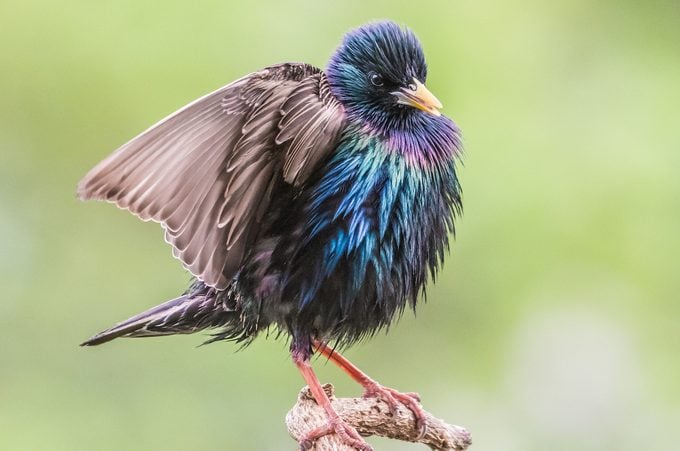
The European starling is an incredible singer. Best of all, starlings begin singing in winter, just when it feels like spring will never come. Male starlings can also mimic the sounds of other birds.
Check out the top songbirds in America.
Do Starling Sightings Have Meaning?
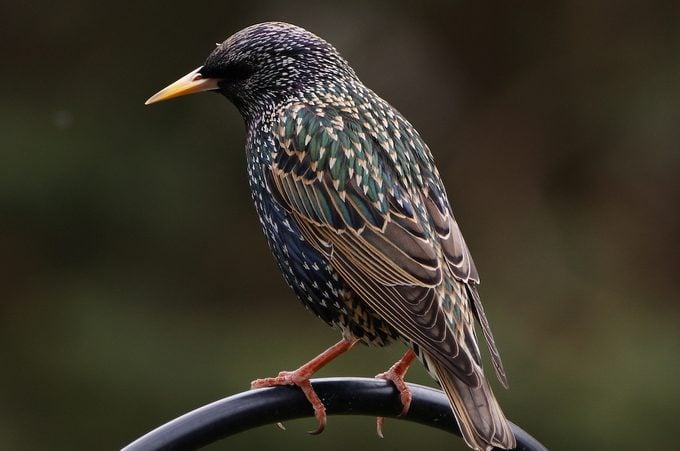
Some people say that a starling is a symbol of family or other close relationships. Others see the birds as a sign of unity or cooperation. This may be because the birds are known for flocking together in large groups. In the 2021 movie “The Starling”, Melissa McCarthy plays a grieving mother who is confronted by an aggressive starling as she attempts to revive her garden. Through her encounters with the bird, she begins to heal and learns to fly again.




















